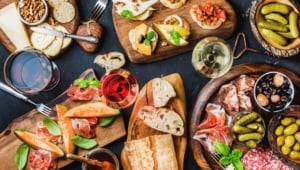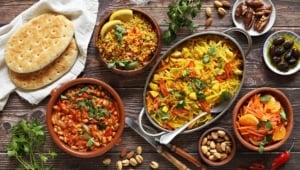Croatian Food: 39 Popular Dishes + 4 Secret Recipe Tips

From savory sausages and flavorful oysters to creamy stews and chocolatey cakes, Croatian cuisine is overflowing with mouthwatering recipes waiting to be devoured. Read on for the most popular Croatian dishes as well as tasty recipe tips.
Between coastal and continental Croatian regions, this country’s gastronomic scene is one to behold. Whether it’s tasty seafood, hearty meat, warming soups, sweet pastries, or fulfilling sandwiches, Croatia’s menu of traditional foods is incredibly rich and inviting.
Our guide to Croatian cuisine will introduce you to the nation’s popular starters, soups, mains, salads, desserts, and more. We’ll sink our teeth into 39 of the top must-try Croatian dishes and talk about 4 secret recipe tips to help you master the ways of Croatian cooking.
Traditional Croatian Cuisine: More than Fig Jams and Olive Oil

Traditional Croatian Cuisine: More than Fig Jams and Olive Oil
The cultural heritage within Croatia is closely tied to the country’s massive list of traditional dishes.
Harboring influences from Hungarian, Italian, and Turkish cuisines, Croatia’s gastronomic scene over the years has managed to translate the nation’s characteristic flavors into dozens upon dozens of distinct dishes that well deserve recognition among international cuisines.
Among the most well-known Croatian foods are olive oil, Pag cheese, and fig jam, but this cuisine has so much more to offer.
Croatian traditional dishes vary depending on the area you’re in; coastal regions have their delicacies and the inland parts of the European country also have theirs. We’ve done our best to give you a taste of every corner of Croatian cuisine.
Most Popular Street Food in Croatia

Most Popular Street Food in Croatia
The street food scene in Croatia is buzzing with intriguing flavors, aromas, and textures. Influenced by the sea, the history, the climate, and the resources, Croatian street food presents foodies with a delicious chance to immerse themselves in the country’s beautiful culture.
Here are a few of our favorite treats you shouldn’t miss the chance to try when exploring the streets of Croatia.
Češnjovka

Češnjovka
Sampling sausages is one of the most interesting and tastiest food-related activities you can enjoy in Croatian streets.
A specialty of Samobor City, Češnjovka is a type of sausage with intense garlic flavors and spicy undertones. It pairs great with red Croatian wines, sauerkraut, and a dab of Samobor’s signature mustard inside a hotdog-like bun.
Pizza

Pizza
Croatia shares a border with Italy from the west and southwest, so it’s no surprise to see pizza sold at food stalls along the streets of Croatia.
This isn’t to say that Croatian pizza exists solely because of Italian influence, but we’re merely highlighting the mark left by Italian cuisine on Croatian food and how the latter added its unique touch to the dish.
You’ll see this clearly when you try prsut pizza made with Croatian prosciutto (dried meat).
Grilled Anchovies/Mackerel/Sardines

Grilled Anchovies/Mackerel/Sardines
Strolling anywhere near the Croatian cost is a chance for you to munch on this grilled dish. It can feature any type of fish from the Mediterranean as long as it’s small enough to be eaten on the go.
As such, anchovies, mackerel, and sardines are typical choices for this popular street snack, commonly seasoned with olive oil, herbs, lemon juice, and salt.
Uštipci
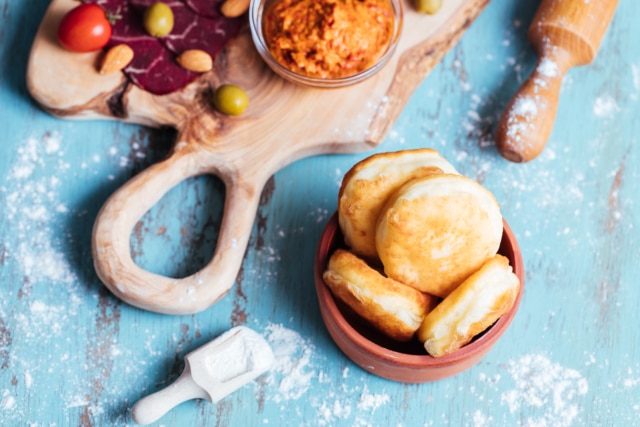
Uštipci
Another Croatian street food you’re bound to come across is Uštipci, which refers to these incredibly versatile deep-fried balls of dough.
You can snack on Uštipci during the day, have it for breakfast, or serve it as a side to your main course. You can even enjoy it savory with ham, ajvar, or cheese; or eat it as a sweet treat with a jam or powdered sugar topping.
The batter is a simple recipe of eggs, flour, yeast, and milk.
Fritule

Fritule
This particular fritter dish has versions across pretty much all countries overseeing the Mediterranean, and in Croatia, it’s known as Fritule.
Enjoyed as a sweet treat, it consists of deep-fried rum/brandy-enriched batter balls with a texture similar to donuts. Toppings differ based on region and preference, but they usually include powdered sugar, sugar syrup, caramel, whipped cream, and chocolate sauce.
Pulled Pork Sandwich

Pulled Pork Sandwich
If you’re craving a juicy, meaty snack to boost your energy while venturing through the streets of Croatia, this pulled pork sandwich will hit just the spot.
A mouthwatering delicacy of Zagreb, the meat featured in this dish goes through at least 24 hours of marination before spending around 8 hours slowly roasting.
The final destination of the shredded meat is a fresh brioche bun, topped with BBQ sauce, sour cream, and red onions.
Croatian Food in the World

Croatian Food in the World
Despite its wide range of flavors, colors, and textures, the status of Croatian cuisine on the international gastronomic scene isn’t as hot as we’d love for it to be.
Perhaps it’s due to limited media exposure in the years before, or the fierce competition imposed by Asian cuisine and Middle Eastern cuisine.
Luckily, the Croatian National Tourist Board has been making serious efforts to change the worldwide popularity of the country’s traditional cuisine, and the results have been quite promising.
In 2020, Croatia was recognized by Chef’s Pencil as the 4th most underrated destination across the globe for foodies seeking a fantastic gastronomic experience.
How Healthy Is Croatian Food?

How Healthy Is Croatian Food?
Croatian cuisine is abundant in all types of foods thanks to the gastronomic diversity resulting from environmental and economic factors. Croatian food is generally categorized into coastal and continental, each with characteristic ingredients that vary in their health benefits.
For example, Croatian food in the coastal region heavily features seafood and fish. These components are renowned for their health benefits as they’re loaded with omega-3 fatty acids, vitamin D, and protein.
They’re associated with a decreased risk of heart disease, enhanced brain functions, lower incidence of depression, and improved overall immunity.
Croatian food also features plenty of reliance on potatoes, which are rich in minerals, antioxidants, and vitamins. However, this cuisine also emphasizes meat, which isn’t necessarily very healthy if not consumed in moderation.
Famous and Popular Croatian Dishes You Have to Try

Famous and Popular Croatian Dishes You Have to Try
Now that you’re more familiar with the food culture in Croatia, it’s time to dive into the many delicious recipes of this cuisine. The following are just a taste of must-try Croatian dishes from different food categories that’ll have you craving for more.
Soups & Salads

Soups & Salads
One of the fascinating aspects of Croatian cuisine is how it contains diverse dishes ranging from light and minimalistic to rich and hearty. So if you’re after soups and salads, you won’t be disappointed as Croatians enjoy them in plenty of shapes and flavors.
Lička Juha

Lička Juha
Translating into Lika soup, this is a perfect example of a winter comfort food that fills you up with its enticing flavors and aroma.
It originates from the Lika region of Croatia, and it features meat bits (veal or lamb), onions, mushrooms, root veggies, parsley, and garlic. In some parts of the country, folks add sour cream and egg yolks right before serving to make the soup even richer.
Šokačka Salata

Šokačka Salata
Hailing from Baranja and Slavonia, this traditional salad is a hearty recipe that may satisfy your hunger all on its own. Ingredients include cooked chicken breast, boiled quail eggs, spring onions, tomatoes, pickles, peppers, sunflower seeds, and pumpkin seeds.
Once you dice up these components, combine them with red vinegar and pumpkin/sunflower oil dressing.
Juha od Oslića

Juha od Oslića
A staple of Dalmatian cuisine also known as hake soup, this recipe calls for hake fish, rice, lemon juice, garlic, olive oil, parsley, and bay leaves.
All the ingredients –except for the rice– are added to cold water, seasoned with salt and pepper, and then cooked until the fish is ready. You’ll then remove the fish, add the rice to cook, and then serve the soup alongside the fish cuts.
Salata od Smucanja i Kuvanih Jaja
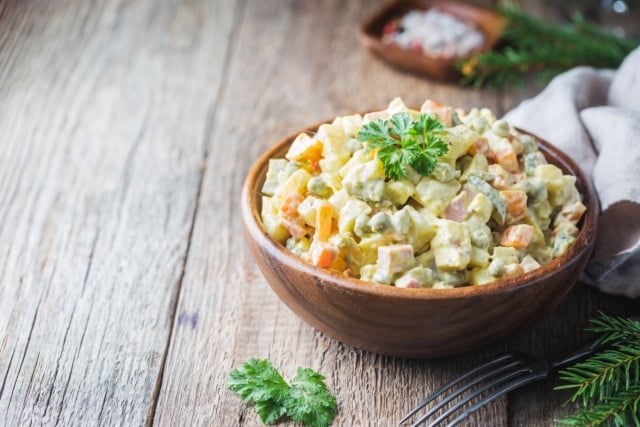
Salata od Smucanja i Kuvanih Jaja
This Croatian salad is a typical dish in the Kvarner region featuring a type of plant called samphire. This unique ingredient is a salt-retaining succulent, which provides the salad with a sea salt taste.
Once cooked, samphire pieces are combined with hard-boiled egg chunks, wine vinegar, olive oil, and black pepper.
Mišanca

Mišanca
Another delicacy of the Dalmatian region is this salad that uses mišanca (a mixture of wild herbs such as leek, onion, fennel, edible flowers, and beet) as the main component.
The bitter, earthy flavors of these herbs and plants are balanced and enhanced by adding olive oil, olives, wine vinegar, pickled anchovies, hard-boiled eggs, and capers.
Juha sa Štruklima

Juha sa Štruklima
With its origin traced to the cultural region of Zagorje, this dish translates into soup with štrukli. True to its name, it features štrukli (dough with a stuffing) swimming in a flavorful soup.
The dough is made thick using flour, vinegar, eggs, water, and salt, whereas the filling is a mixture of cow cheese, salt, and eggs. The štrukli is then cooked in savory onion and paprika soup.
Salata od Liganja i Krumpira

Salata od Liganja i Krumpira
Croatian for calamari and potato salad, this scrumptious recipe hails from the Dalmatian coast. This explains the use of seafood –squid to be precise– in the salad along with onion and potatoes.
The depth of flavor comes from the incorporation of vinegar, olive oil, salt, and black pepper. Once the sliced squid and cubed potatoes are cooked, the dressing is added and the salad is either immediately served or enjoyed chilled.
Zagorska Juḫa s Vrganjima

Zagorska Juḫa s Vrganjima
Another traditional treat from the Zagorje region, this soup is hearty, creamy, savory, and fulfilling. To whip it up, you need a few types of cured meat along with boletus mushrooms, carrots, potatoes, sour cream, white wine, garlic, and onions.
Served in cold weather and doubling as a hangover remedy, its spice mixture includes paprika, bay leaves, black pepper, and salt.
Pretepena Juha

Pretepena Juha
Translating to beaten soup, Pretepena Juha is a creamy, thick, and nourishing soup typically served in cold weather. It originated from the Međimurje area and is –luckily– still prepared the way folks did it back then.
This comforting recipe features sausage pieces, dried pork bits, sour cream, flour, stock, eggs, onion, diced gourd, garlic, salt, and pepper.
Popurena Salata

Popurena Salata
Also called a smoked salad, this is a simple dish that uses readily available, inexpensive ingredients so that any household can enjoy it no matter how modest.
To make it, you need to heat the vinegar with water, sugar, and salt. Add pork fat and wait for it to melt before mixing in lettuce leaves. Serve warm, traditionally alongside Popara; a Croatian version of bread mash.
Starters, Sandwiches & Sides

Starters, Sandwiches & Sides
The food culture in both the Croatian coast and inland is no short of starters, sides, or sandwiches. Croatian cuisine loves the idea of combining and complementing flavors, which gives us a wide range of recipes to talk about in this section. Below are a few of our favorites.
Ćevapčići

Ćevapčići
If you want a gateway to the sandwich world of Croatian foods, Ćevapčići makes for a scrumptious introduction. It consists of small sausages or meatballs made using multiple types of meat (including pork, beef, lamb, and mutton) and seasoned with paprika, garlic, parsley, plus onions.
To serve, arrange the meatballs on flatbread and top with ajvar relish, kajmak cream, and chopped onions.
Abšmalcane (Abshmalcan) Mahune

Abšmalcane (Abshmalcan) Mahune
Hailing from Zagreb, this side dish offers a nice flavor coupled with an intriguing texture that you can enjoy as a snack or use to enrich your fish or meat meal.
The main ingredient is green beans, which are cut in halves and boiled until soft. A mixture of butter, bread crumbs, and garlic is fried separately and then added on top of the cooked green beans when it’s serving time.
Njoki

Njoki
A signature dish of the Croatian coast, Njoku is a delish dumpling recipe that’s typically served alongside a meat main (such as pašticada) or as a snack (if you’re familiar with Italian cuisine, gnocchi is the corresponding version).
It’s made using potato dough, flour, boškarin meat, olive oil, garlic, onions, red wine, marjoram, black pepper, bay leaves, and tomatoes.
Sarma

Sarma
One of the most delicious Croatian foods that serve as a starter, side, and main is known as sarma, which translates into cabbage rolls.
Pretty much every Balkan and continental European country has a version of this dish; Croatians use pickled cabbage leaves to wrap a filling of meat and rice.
They then cook the rolls alongside bacon or dry-smoked beef for at least 2 to 2.5 hours. It’s typically paired with bread to soak up the flavorful liquid that results from cooking.
Istarska Jota

Istarska Jota
A specialty of Istrian regions and the Adriatic coast, this hearty stew is traditionally a working man’s dish that nourishes and warms the body.
Nowadays it’s a simple savory side or starter that everybody enjoys to the point of crowning it as a national dish.
Istarska jota features smoked bacon, smoked small ribs, sauerkraut, beans, olive oil, potatoes, onions, and garlic with a seasoning of bay leaves, black pepper, parsley, and salt.
Fuži

Fuži
Another delicacy from Istria is this pasta dish known as fuži, which uses hand-rolled pasta pieces shaped like small tubes that look similar to penne pasta.
This signature pasta is cooked and coupled with a stew or sauce, commonly chicken goulash or red veal sauce. A combination of white truffle shavings and olive oil is a must-add topping, paired with an Istrian white wine to bring the dish to a heavenly level.
Punjena (Stuffed) Paprika

Punjena (Stuffed) Paprika
Once peppers are in season, Croatians like to indulge in a dish known as Punjena paprika or stuffed peppers. While you’ll find a version of this recipe in most Balkan countries, Croatian cuisine has a unique take that many deem as the best.
Fresh peppers are hollowed out and filled with a mixture of rice, meat (beef or pork), egg, garlic, and onion along with various herbs and spices. Cooked in umami tomato sauce. This popular side also doubles as a main and is often paired with mashed potatoes.
Soparnik

Soparnik
Listed as a national heritage recipe by the European Commission, Soparnik is a traditional Dalmatian food that we like to describe as a vegetarian flat pie.
The thin dough layers are stuffed with Swiss cheese, parsley, garlic, spring onions, olive oil, and salt. The pie is then pricked and baked in a special fireplace (Komin) with hot coal placed on top of it for about 30 minutes.
Once fully cooked, the embers are removed and the pie is brushed with an olive oil and garlic mixture.
Pljeskavica

Pljeskavica
This dish is technically a sandwich as it resembles the common perception of a hamburger. Pljeskavica refers to the meat patty featured in the dish that’s usually served over a type of flatbread (instead of buns) alongside potato fries.
The meat can be beef, pork, lamb, or their combinations and the toppings usually include onions, tomatoes, and peppers.
Žganci

Žganci
A Croatian dish that’s also popular in Slovenia, Žganci is traditionally a “poor man’s” meal that’s usually served warm accompanied by milk, honey, cream, yogurt, fried bacon, or lard.
The recipe is quite simple, calling for cornstarch, butter, water, and salt. To make it, you’ll stir the ingredients for about 15 minutes on the stove and remove it from heat after it turns very thick.
Mains

Mains
When main dishes are in question, Croatian cuisine turns into a feast of recipes centered around seafood (across coastal Croatia) and meat (throughout continental Croatia).
Boasting incredible flavors and aromas, here are some of the most unforgettable main courses you don’t want to overlook.
Brudet/Brodet

Brudet/Brodet
A Dalmatian coast classic, a brudet or brodet is a warm, hearty stew made using an assortment of fresh seafood and fish (added with its bones), including monkfish, conger, forkbeard, shrimp, and mussels.
Other ingredients feature seafood stock, tomato sauce, wine (red or white), vegetables, and vinegar. To boost the flavors, rosemary, parsley, and bay leaves are added among other spices and herbs.
Schnitzel (Zagrebački Odrezak)

Schnitzel (Zagrebački Odrezak)
Filled with tasty richness, this schnitzel recipe is courtesy of the city of Zagreb where it’s quite popular during the winter. It consists of hammered veal slices stuffed with cheese and cooked ham.
Each stuffed piece is then coated in breadcrumbs, flour, and eggs, and then fried in a pan to create a crispy layer on the outside that beautifully contrasts with the juicy, tender inside. A side of risotto, salad, and/or fries typically accompanies the Capital’s schnitzel.
Pašticada
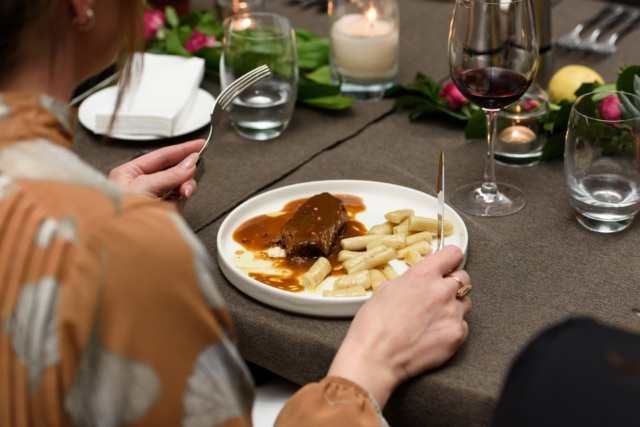
Pašticada
The Dalmatian regional cuisine is home to many meaty delicacies; on top of that list is pašticada.
It’s made up of a beef steak stuffed with cloves, carrots, garlic, and bacon then left to soak in a vinegar marinade and cooked in a red wine sauce with tomato paste, dried fruits (figs and prunes), celery root, and parsley root.
Oozing flavorful juices, the meat is commonly served with a Njoku side.
Šestinska Pečenica (Roast)

Šestinska Pečenica (Roast)
This roast pork recipe is popular throughout the Croatian capital thanks to its savory, juicy, meaty goodness.
To make it, rub some pork cubes with salt then arrange them on a skewer and place them on a grill. Once the meat turns a deep brown, serve it hot alongside ajvar dip and raw onions for a peppery and spicy kick of flavor.
Šaran U Rašljama

Šaran U Rašljama
A one-of-kind Croatian delicacy, this dish features carp fish that you cut along the spin to end up with halves.
The fish is seasoned with paprika (sweet and hot) and sea salt and then placed on wooden sticks/forks (hazel) to be cooked for about 2 hours, turning the fish once halfway through the duration and once again towards the last 20 minutes.
Sides include potato and white wine while the dressing is usually olive oil, garlic, and parsley.
Kulen

Kulen
Among the rich list of sausages and salami you can find in Croatia, Kulen is one of the country’s finest products and is even considered the best of all Croatian sausages.
The meat is sourced from Slovanian free-range pork with a diet consisting of organic barley, corn, and acorns. Once stripped of connective and fatty tissue, the meat is spiced with garlic, salt, and paprika, shaped into sausage, and smoked for months on end.
Kotlovina

Kotlovina
This traditional Croatian platter-style main dish is sort of a celebration of the deliciousness of meat, be it beef, pork, or chicken. The meat is first fried with onions on a special pan and then cooked in water and wine to give a flavorful stock.
Then, the meat is placed on the edge of the pan to allow the potatoes, beans, sausages, and mushrooms to slowly cook in the middle.
Fiš Paprikaš
The name of this recipe translates into fish stew, which gives a clear idea of what to expect from it. Enjoyed throughout Serbia, Hungary, and Croatia, this meal is traditionally slow-cooked over an open fire.
Ingredients include freshwater fish such as pike, carp, or catfish along with generous amounts of red paprika powder. You can enjoy this dish as is or couple it with egg noodles.
Crni Rizot

Crni Rizot
There’s no way better than Crni Rizot to wrap up the main dish section given its immense popularity in Croatia.
Translated into black risotto, this unique Dalmatian meal delivers one of the most intense seafood flavor and aroma profiles in the world, prepared using squid or cuttlefish whose ink dyes the rice in intimidating black. Other ingredients include prawn, garlic, olive oil, white wine, onions, and Vegeta.
A simple topping of parmesan and parsley provides just the right finish.
Bread, Pastries & Desserts

Bread, Pastries & Desserts
The diversity and richness of Croatian cuisine are evident in the way that even desserts and baked goods have a strong presence within the country’s food culture. Croatian folks love their sweets, bread, and pastries — and we do too. Here are a few of our favorites.
Rapska Torta

Rabska Torta
Also known as Rab cake, this dessert hails from Rab, a Croatian island standing in the Adriatic Sea.
Dating back to the 12th century, it calls for flour, eggs, butter, salt, sugar, orange zest, and lemon zest, with the added star ingredients: Maraschino liqueur and almonds.
Another traditional signature of this cake is its spiral shape, which also makes it a popular souvenir (that and its long shelf life).
Rozata

Rozata
Originating in southern Croatia in the city of Dubrovnik, Rozata is a fusion of pudding and custard. It calls for a few simple ingredients; milk, eggs, and sugar, along with Rozalin (a local liquor) to give the treat its characteristic flavor.
Once combined, the mixture is baked in containers lined with plenty of caramel to produce a creamy dessert with a generous layer of sweetness on top. For extra freshness, you can incorporate lemon zest.
Zagorski (Zagorje) Štrukli

Zagorski (Zagorje) Štrukli
A popular and versatile pastry in Croatian cuisine for centuries, Zagorje štrukli is actually on the country’s list of intangible cultural heritage.
This recipe is enjoyed as salty or sweet, baked or cooked, and as a starter, dessert, or main dish. The dough sheets are made from flour, oil, eggs, and water, whereas the stuffing is typically a mixture of cottage cheese, sour cream, and crème fraîche.
Mađarica

Mađarica
If you’re in the mood for a chocolatey treat, Croatian cuisine has your back with its mouth-watering mađarica recipe.
Translated into Hungarian girls, this dessert is a layered chocolate with rich chocolate cream filling. It’s closely tied to celebrations and calls for ingredients such as flour, egg whites, butter, sugar, cream, chocolate, milk, and vanilla.
The topping is traditionally a dark chocolate glaze that gives the flavors extra depth.
Viška (Komiška) Pogača

Viška (Komiška) Pogača
Although it translates to “excess cake”, this recipe is what you get when you cross pie with bread. It’s a baked good made using flour, olive oil, water, yeast, and rosemary.
As you let the dough rest for around 45 minutes, you’ll fry chopped onions along with peeled tomatoes and a seasoning of pepper.
Once you roll the dough into two layers, place one in an oiled baking pan then add anchovies, fried mix, and olives then cover with the other layer and slip into the oven for 45 minutes.
Rafioli

Rafioli
This sweet dish comes with an equally sweet legend where a lady imprisoned in the Trogir tower baked treats as she waited for liberty; her favorite was Rafioli. When a Trogir nobleman saved her, she made him Rafioli for as long as she lived.
Shaped like a half-moon, this shortbread cookie traditionally features a sugary almond filling, but nowadays vanilla and lemon/orange zest are added for extra flavor. A modern twist replaces the almond filling with chocolate and cream stuffing.
Pinca

Pinca
This bread recipe is a staple of easter traditions in Croatia. It’s quite elaborate and time-consuming with lots of details to consider, for example, you need to let the dough rise three times and wait about an hour each time.
Done right, the baking duration should be around half an hour. The result is worth the hassle as you get to enjoy a soft, light, and foamy texture with a rich and sweet flavor. The addition of raisins and candied fruits elevates the taste. Pair with a cup of warm tea or coffee.
Kroštule

Kroštule
Croatian for crumbs, Kroštule is a crunchy, sweet dish originating from Dalmatian and Istrian cuisine. While it does look like a plate of crumbs, it’s made using dough that consists of flour, milk, oil, egg yolks, and sugar.
Orange zest/liqueur, limoncello, and lemon zest are typical flavoring agents. The dough is cut into ribbons or knots and deep fried then topped with powdered sugar. It’s best served warm alongside a cup of coffee.
Samoborska Kremšnita
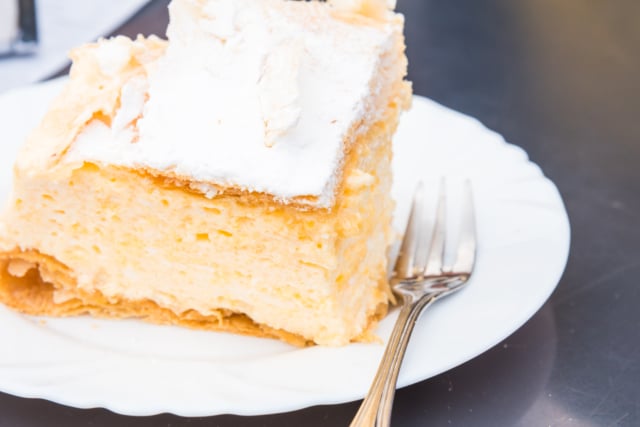
Samoborska Kremšnita
A specialty of Samobor city in Zagreb, Samoborska kremšnita is a rich, buttery, and sweet treat with a crispy outer layer and a mushy filling for an intriguing contrast in texture with every bite.
This recipe consists of flaky, crispy puff pastry at the top and bottom, while the middle layer is a generous amount of custard cream. You can add whipped cream as a topping or keep it simple with a dusting of powdered sugar. Serve chilled or warm.
Burek

Burek
Last but not least, a staple in Croatian cuisine as well as Balkan countries, Burek is the ultimate baked pastry dish. It can be an appetizer, a side, a main dish, or a dessert depending on the filling and the time of serving.
Stuffing options are diverse, ranging from meat (beef, lamb, pork) and vegetables (zucchini, potatoes, eggplant) to cheese (ricotta, parmesan, feta) and fruits (mainly apples and cinnamon mixture).
To make the dough, you need to combine flour, olive oil, salt, and water. Roll it into thin sheets and then assemble alternate layers of dough and filling.
Secret Recipe Tips for Croatian Food

Secret Recipe Tips for Croatian Food
Here are some tricks to help you master Croatian cooking:
- Learn the Peka cooking method: Preparing seafood, meat, and vegetables in this bell- or dome-shaped vessel is a tradition within Croatian cuisine.
- Get familiar with the Buzara technique: Cooking seafood in garlic, olive oil, wine, and herbs is a characteristic of Croatian cuisine.
- Keep your ingredients fresh: Croatian recipes are all about using fresh seafood, vegetables, dough, and so on.
- Use Croatian olive oil: Premium Croatian olive oil is a fundamental element in all signature Croatian flavors.
Beverages in Croatian Cuisine

Beverages in Croatian Cuisine
Croatian cuisine is home to various beverages that are as unique to the country’s culture as its food. The spotlight in this department is saved for the wines, but there are also juices and caffeinated beverages deserving of recognition.
Here are some of Croatia’s most popular drinks and a few of our favorites to sip on.
Pasareta

Pasareta
First up is a non-alcoholic beverage with a distinct vibrant red color. A staple of summertime in Croatia since 1924, this drink is a specialty of Istria consisting of water and sugar along with a fruity aroma.
Pasareta is such an iconic drink of Istrania that the manufacturer depends only on word of mouth as advertising.
Rakija

Rakija
This is the king of alcoholic beverages in Croatia, and it refers to multiple types of brandies extracted from various fruits.
Among the most popular makes are viljamovka (pear), šljivovica (plums), and kajsijevača (apricots). Most Croatians enjoy this strong spirit neat and well-chilled, typically in a shot glass. Beyond enhancing the time spent socializing, they believe it has remedial benefits.
Plavac Mali

Plavac Mali
Produced in the Dalmatian region of the country, Plavac Mali is a dessert wine with subtle sweet undertones and fruity aromas.
It’s the result of a special technique where grapes are pressed after drying. The most notable type of grapes used is Plavac Mali, but other common varieties include Maraština, Vugava, and ogdanuša.
It’s typically consumed alongside desserts, but it also pairs well with cheese and nuts.
Bijela Kava

Bijela Kava
Coffee is integral to the food and beverage scene in Croatia, so it comes as no surprise that this caffeinated drink made it into our list.
Bijela kava translates into white coffee, which gives you an idea of what to expect from this beverage. It consists of an intense espresso shot with a generous amount of warm milk.
Black Tea

Black Tea
With origins rooted in the Ottoman Empire, black tea is a widely loved beverage throughout Croatia, especially black varieties such as Earl Grey, Assam, and Darjeeling. Folks enjoy it over breakfast, after lunch, and during social encounters in cafés and tea rooms. They typically serve it plain or with milk.
Common Ingredients in Croatian Cuisine

Common Ingredients in Croatian Cuisine
To help you kickstart your journey exploring Croatian cuisine, we’ve put together a list of the most regularly used ingredients in Croatian recipes. Stocking up on them will set you up for a smooth experience.
- Olive Oil: As we’ve established throughout today’s guide, olive is crucial to Croatian cuisine. It’s made from locally sourced premium olives.
- Garlic: Spicy and aromatic, Croatian cuisine features garlic in everything from stews to sausages to pies.
- Paprika: You’ve seen us mention paprika many times today, and that’s because Croatian cuisine loves paprika, especially in meat recipes.
- Ajvar: This ingredient is a concoction made from eggplant, olive oil, red capsicum, and garlic. It’s a staple in roasted and grilled meat recipes.
- Cabbage: From rich soups to hearty rolls, cabbage has a strong presence in Croatian food culture.
- Potatoes: A common theme in traditional "affordable" Croatian meals, potatoes are a main ingredient in many salads, sides, and mains.
Herbs and Spices in Croatian Cuisine

Herbs and Spices in Croatian Cuisine
Building up on the list above, here are a few of the most common herbs and spices you’ll use in Croatian-style cooking:
- Rosemary: Added to soups, roasts, cheeses, sauces, and stews, rosemary is intense, woody, balsamic, peppery, and slightly bitter.
- Basil: A staple in salads and appetizers, rosemary is pungent and sweet with a spicy undertone.
- Oregano: A highly aromatic herb with a pungent and spicy taste.
- Black Pepper: It has a sharp flavor and aroma with a biting, piney, and hot taste.
- Marjoram: A woody herb with citrusy and sweet flavors.
Croatian Food Culture

Croatian Food Culture
To wrap up, let’s take a look at some main themes of Croatian food culture. Learn more about the eating habits and etiquette in Croatian cuisine.
Eating Habits

Eating Habits
Croatians are big on seafood and meats with a glass of wine typically accompanying their meals. They also greatly appreciate stews and soups.
They prefer eating in groups and avoid any form of wasting food. They’re quite generous when offering food to guests and will often say a short prayer before starting to eat.
Meal Structure

Meal Structure
Croatians stick to the basic meal frequency of three times a day, but they also make time for multiple coffee sessions throughout the day. The most important meal is lunch; most Croatians will head home for lunch and then go back to school or work.
Etiquette

Etiquette
Croatians never put their hands below the table during meals; so keep yours above the table unless you want to come off as rude. Toasting is common during meals and so is saying grace before eating. Also, Croatians wait for everyone to sit at the table before starting to eat.





